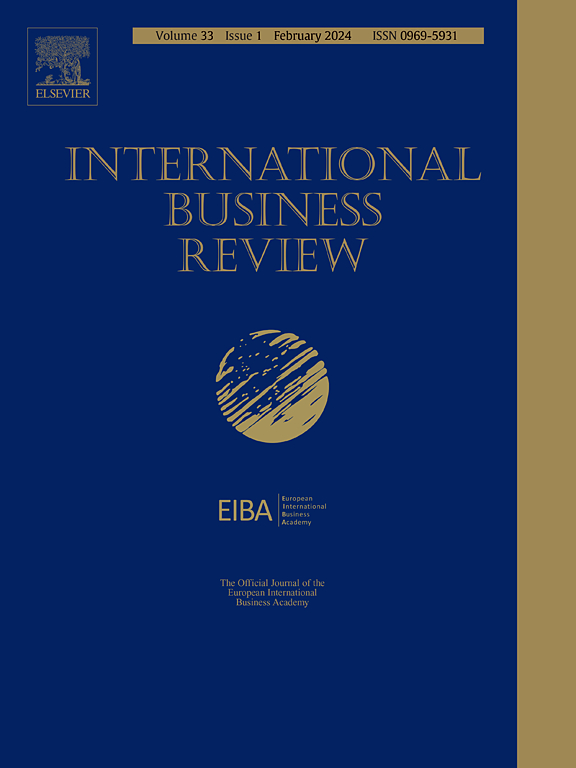Modeling serendipity in opportunity search by born-global firms: Performance implications from a computer simulation of evolutionary drift using NKC methodology
IF 6.1
1区 管理学
Q1 BUSINESS
引用次数: 0
Abstract
Although the importance of serendipity in international entrepreneurship is well established, no one has yet inquired into what level of serendipity best enables firms to discover and exploit opportunities. This paper conceptualizes serendipity as evolutionary drift and draws on the theory of neutrality from evolutionary biology to quantify the degree of serendipity that born-global firms (BGs) adopt in pursuit of opportunities modeled as a set of performance peaks on an evolutionary performance landscape. Using an enhanced version of NKC methodology, computer simulations test variations among BGs in terms of their organizational structure, levels of complexity, and the degree of neutrality, which is used as a proxy for reliance on serendipity in opportunity search. Contrary to expectations of an inverted U-shaped relationship between serendipity and BG performance, the simulations provide strong evidence for a U-shaped relationship. In other words, performance is higher when BGs rely on either a high degree of serendipity (high neutrality, wide scope of opportunity search, high level of exploration) or a low degree of serendipity (low neutrality, narrow scope of opportunity search, low level of exploration). In more practical terms, this finding suggests that BGs can achieve high performance in their opportunity search by putting their employees or subunits either on a “tight leash” (low serendipity) or on a “loose leash” (high serendipity) in pursuit of opportunities but should avoid medium degrees of serendipity.
全球性公司在机会搜索中的偶然性建模:使用NKC方法的计算机模拟进化漂移的绩效影响
虽然意外发现在国际创业中的重要性已得到公认,但还没有人探究过什么程度的意外发现最能使公司发现和利用机会。本文将偶然性概念化为进化漂变,并利用进化生物学中的中性理论来量化全球企业(BGs)在追求机会时采用的偶然性程度,这种偶然性被建模为进化绩效景观上的一系列绩效峰值。使用改进版的NKC方法,计算机模拟测试了bg在组织结构、复杂程度和中立性方面的差异,中立性被用作机会搜索中对偶然性依赖的代理。与人们对意外发现和天然气性能之间呈倒u型关系的预期相反,模拟结果为u型关系提供了强有力的证据。换句话说,当bg依赖于高度的偶然性(高度中立性,广泛的机会搜索范围,高水平的探索)或低程度的偶然性(低中立性,狭窄的机会搜索范围,低水平的探索)时,绩效会更高。从更实际的角度来看,这一发现表明,大企业集团可以通过让员工或下属单位在追求机会时“严格控制”(低偶然性)或“宽松控制”(高偶然性)来实现高绩效,但应避免中等程度的偶然性。
本文章由计算机程序翻译,如有差异,请以英文原文为准。
求助全文
约1分钟内获得全文
求助全文
来源期刊

International Business Review
BUSINESS-
CiteScore
14.10
自引率
6.90%
发文量
95
审稿时长
62 days
期刊介绍:
The International Business Review (IBR) stands as a premier international journal within the realm of international business and proudly serves as the official publication of the European International Business Academy (EIBA). This esteemed journal publishes original and insightful papers addressing the theory and practice of international business, encompassing a broad spectrum of topics such as firms' internationalization strategies, cross-border management of operations, and comparative studies of business environments across different countries. In essence, IBR is dedicated to disseminating research that informs the international operations of firms, whether they are SMEs or large MNEs, and guides the actions of policymakers in both home and host countries. The journal warmly welcomes conceptual papers, empirical studies, and review articles, fostering contributions from various disciplines including strategy, finance, management, marketing, economics, HRM, and organizational studies. IBR embraces methodological diversity, with equal openness to papers utilizing quantitative, qualitative, or mixed-method approaches.
 求助内容:
求助内容: 应助结果提醒方式:
应助结果提醒方式:


